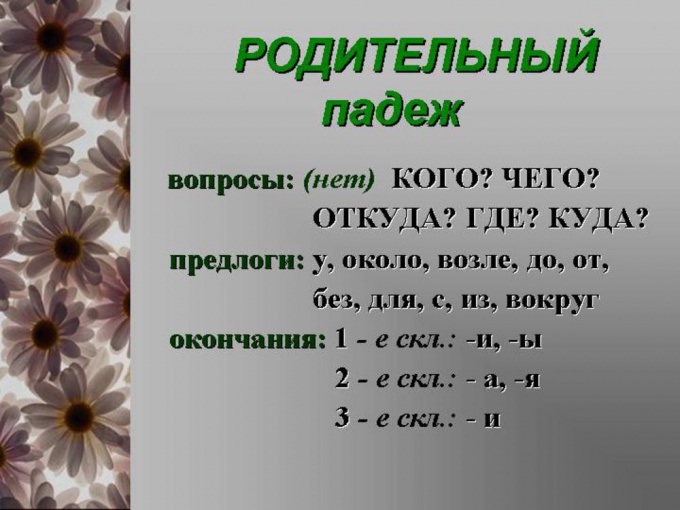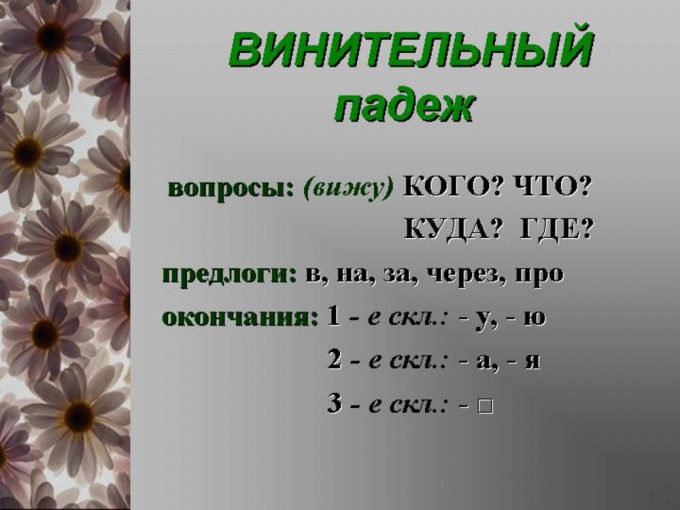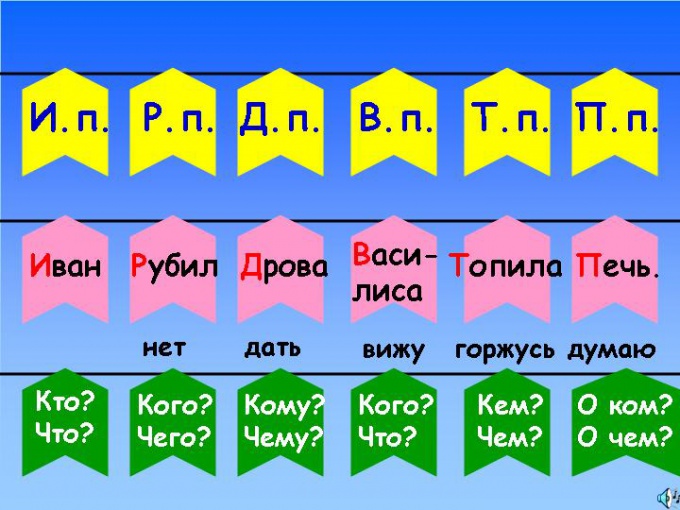You will need
- • Nouns in the genitive and accusative cases.
- • Knowledge of definitions of cases.
- • Knowledge of issues concerning the case.
Instruction
1
In the Russian language has six cases for nouns: nominative, genitive, dative, accusative, instrumental and prepositional. Such names given them for a reason. Consider only two cases: genitive and accusative.
2
Genitive
According to the definitions in the Russian language, the genitive indicates:
• Belonging to someone or something, such as "skin Fox", "teacher's journal";
• If the ratio of the whole and its parts, for example "page of the journal (R. p.)";
• Display characteristic of an object relative to another object, such as survey results (R. p.)";
• The object of influence in the presence of the verb with the negative particle "not", e.g. "do not eat meat (R. p.)";
• The object of influence in the presence of a verb indicating desire, intention, or delete, for example, "to be happy (R. p.)", "to avoid responsibility (p. R.)";
• If there is a comparison of items, such as "stronger than oak (R. p.)";
• If the noun is the object of measurement, bills or genitive date, such as "a spoonful of sour cream" or "Day of the Paris Commune".
According to the definitions in the Russian language, the genitive indicates:
• Belonging to someone or something, such as "skin Fox", "teacher's journal";
• If the ratio of the whole and its parts, for example "page of the journal (R. p.)";
• Display characteristic of an object relative to another object, such as survey results (R. p.)";
• The object of influence in the presence of the verb with the negative particle "not", e.g. "do not eat meat (R. p.)";
• The object of influence in the presence of a verb indicating desire, intention, or delete, for example, "to be happy (R. p.)", "to avoid responsibility (p. R.)";
• If there is a comparison of items, such as "stronger than oak (R. p.)";
• If the noun is the object of measurement, bills or genitive date, such as "a spoonful of sour cream" or "Day of the Paris Commune".

3
Accusative case
According to the definitions in russkom language accusative case indicates:
• The transition from the action to the object, such as "flipping magazine", "drive";
• The transfer of spatial and temporal relations to "walk a mile", "rest month";
• In rare cases there is a like dependence on adverbs, e.g. "it's a shame for the other."
According to the definitions in russkom language accusative case indicates:
• The transition from the action to the object, such as "flipping magazine", "drive";
• The transfer of spatial and temporal relations to "walk a mile", "rest month";
• In rare cases there is a like dependence on adverbs, e.g. "it's a shame for the other."

4
Never to confuse the cases of the noun, it is important to remember that each case in the Russian language corresponds to the universal question, asking which is the noun, the result of the appropriate case.
The genitive case corresponds to the question "no what?" for animate and "no what?" for inanimate nouns.
The accusative case corresponds to the question "see who?" for animate and "see what?" for inanimate nouns.
To determine the cases of nouns according to his definitions and the endings are extremely difficult. For example, memorize all the definitions, the genitive and accusative cases is quite difficult. And the endings of the nouns are quite often the same.
Here is an example using tushilnogo noun in the plural :
Nearby I noticed people (see who? - V. p.)
No people were around (who wasn't? - R. p.)
As you can see, inclines in both cases the word the same way.
But, in order to finally verify the correctness of the case, the substitute is to mentally animate noun inanimate.
For example:
Nearby I noticed a post (see who? - V. p.)
There were no posts (not was whom? - R. p.)
The example shows: inanimate noun in the accusative case is not altered in contrast to the same noun with the genitive.
The genitive case corresponds to the question "no what?" for animate and "no what?" for inanimate nouns.
The accusative case corresponds to the question "see who?" for animate and "see what?" for inanimate nouns.
To determine the cases of nouns according to his definitions and the endings are extremely difficult. For example, memorize all the definitions, the genitive and accusative cases is quite difficult. And the endings of the nouns are quite often the same.
Here is an example using tushilnogo noun in the plural :
Nearby I noticed people (see who? - V. p.)
No people were around (who wasn't? - R. p.)
As you can see, inclines in both cases the word the same way.
But, in order to finally verify the correctness of the case, the substitute is to mentally animate noun inanimate.
For example:
Nearby I noticed a post (see who? - V. p.)
There were no posts (not was whom? - R. p.)
The example shows: inanimate noun in the accusative case is not altered in contrast to the same noun with the genitive.
5
Hence we can conclude:
1. To distinguish the genitive from accusative, the noun determines the set question.
2. If you find it difficult to determine the case of the animate noun, because the question "who?" applies to both cases, then substitute this inanimate noun and ask the defining question. For the genitive it is "no what?" but for accusative, "see what?". If the floor will look like in the nominative case, then the case of your noun – accusative.
1. To distinguish the genitive from accusative, the noun determines the set question.
2. If you find it difficult to determine the case of the animate noun, because the question "who?" applies to both cases, then substitute this inanimate noun and ask the defining question. For the genitive it is "no what?" but for accusative, "see what?". If the floor will look like in the nominative case, then the case of your noun – accusative.
Useful advice
In Russian, there are indeclinable nouns, e.g., "coat", "coffee", when in any case the word looks the same. In this case, the case can be determined only on the key question.
